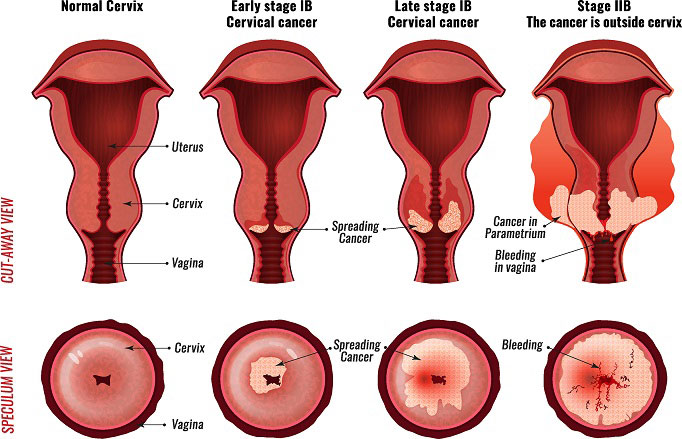Cervical cancer originates in the cervix, a connective tissue at the lower portion of the uterus connecting to the vagina. Each year, about 14,000 women in the United States learn they have cervical cancer. Cervical cancer is one of the most common types to affect a woman’s reproductive organs. Most cases of cervical cancer are caused by the human papillomavirus (HPV).
Before cervical cancer appears, the cells of the cervix go through precancerous changes known as dysplasia, abnormal cell growth that has the potential to spread around the body. It is these abnormal cell changes that an annual Pap test can help to detect. For some women, these changes may go away without any treatment. More often, they need to be treated to keep them from changing into cancer.
Because so many women do have Pap tests annually, deaths from cervical cancer have decreased greatly and are now rare in the United States. Chances of successfully treating cervical cancer are highest when detected early.
Cervical Cancer Symptoms
Early cervical cancer usually has no noticeable symptoms, but it can be detected with yearly check-ups that include getting a Pap test to check for abnormal cells in the cervix.
Possible signs of cervical cancer include vaginal bleeding and pelvic pain or discharge, although other conditions may cause the same symptoms.
You should see your doctor if any of the following problems occur:
- Vaginal bleeding after intercourse, between periods or after menopause.
- Unusual vaginal discharge that is watery, bloody or has a foul odor.
- Pelvic pain or pain during intercourse.
Types of Cervical Cancer
There are two main types of cervical cancer each developing in different tissue. The most common (about 80 to 90 percent) are squamous cell carcinomas. The other 10 to 20 percent are adenocarcinomas.
Squamous cell carcinoma develops in the lining of the cervix. Adenocarcinoma develops in gland cells that produce cervical mucus. There is some controversy over whether patients with adenocarcinoma of the cervix have a worse prognosis than those with squamous cell carcinoma. Some types of adenocarcinoma are aggressive and are associated with a poor outcome.
The most important factor of prognosis is the stage of the cancer. The stage will determine the treatment options and outcomes. Treatment options are the same regardless if a cervical cancer is squamous or adenocarcinoma.

Causes of Cervical Cancer
A sexually transmitted virus called the human papillomavirus (HPV) causes almost all cases of cervical cancer. HPV usually goes away by itself. Most people with HPV never even know they have it. But sometimes an HPV infection can cause problems. HPV can be categorized into two groups: low risk and high risk. Some high-risk types of HPV may stimulate the growth of precancerous cells in the cervix. If these abnormal cells are not found and treated, they may become cancerous.
Two of the high-risk strains are HPV 16 and HPV 18. Two of the low-risk strains are HPV 6 and HPV 11. The HPV vaccine, Gardasil®, protects against these four strains. HPV 16 and HPV 18 account for about 70 percent of all cervical cancers, as well as, a smaller percentage of vaginal and vulvar cancers.
Studies are being conducted to develop vaccines to prevent the remaining 30 percent of cervical cancers. Some low-risk strains, such as HPV 6 and HPV 11 can cause genital warts, but do not cause cervical cancer. These low-risk strains account for about 90 percent of genital warts.
Risk Factors for Cervical Cancer
Women with certain risk factors may be more likely to develop cervical cancer. These factors include:
- Infected with human papillomavirus (HPV) – Some types of HPV can cause changes to cells in the cervix. The changes may lead to genital warts, precancerous growths or cancer.
- Age – The risk of cervical cancer increases with age and most often is diagnosed in women over 40. However, younger women are often diagnosed with precancerous lesions that require treatment to prevent cancer.
- Smoking – Cigarette smoke contains chemicals that damage the body’s cells. Smoking increases the risk of precancerous changes in the cervix, especially in women with HPV.
- Sex at an early age – Women who have had sex at an early age have a higher risk of cervical cancer. Researchers are not sure why, but they think HPV may more easily infect a younger woman’s cervix.
- Number of sexual partners – Women who have had more sexual partners have a greater chance of getting HPV.
- Sexually transmitted diseases (STDs) – Women who have an STD besides HPV have a higher risk of cervical cancer.
- Weakened immune system – Women who are HIV-positive or take drugs that suppress the immune system, such as those who have undergone organ transplant or take steroids for other reasons, have a higher than average risk.
- Lack of regular Pap tests – Cervical cancer is more common among women who do not have regular Pap tests. The Pap test helps doctors find precancerous cells. Treating precancerous cervical changes often prevents cancer. In most cases, cervical cancer is treatable or preventable if caught at an early stage.
Make an Appointment With a Cervical Cancer Expert
To make an appointment with a cervical cancer expert at MD Anderson at Cooper, please call 855.MDA.COOPER (855.632.2667).
